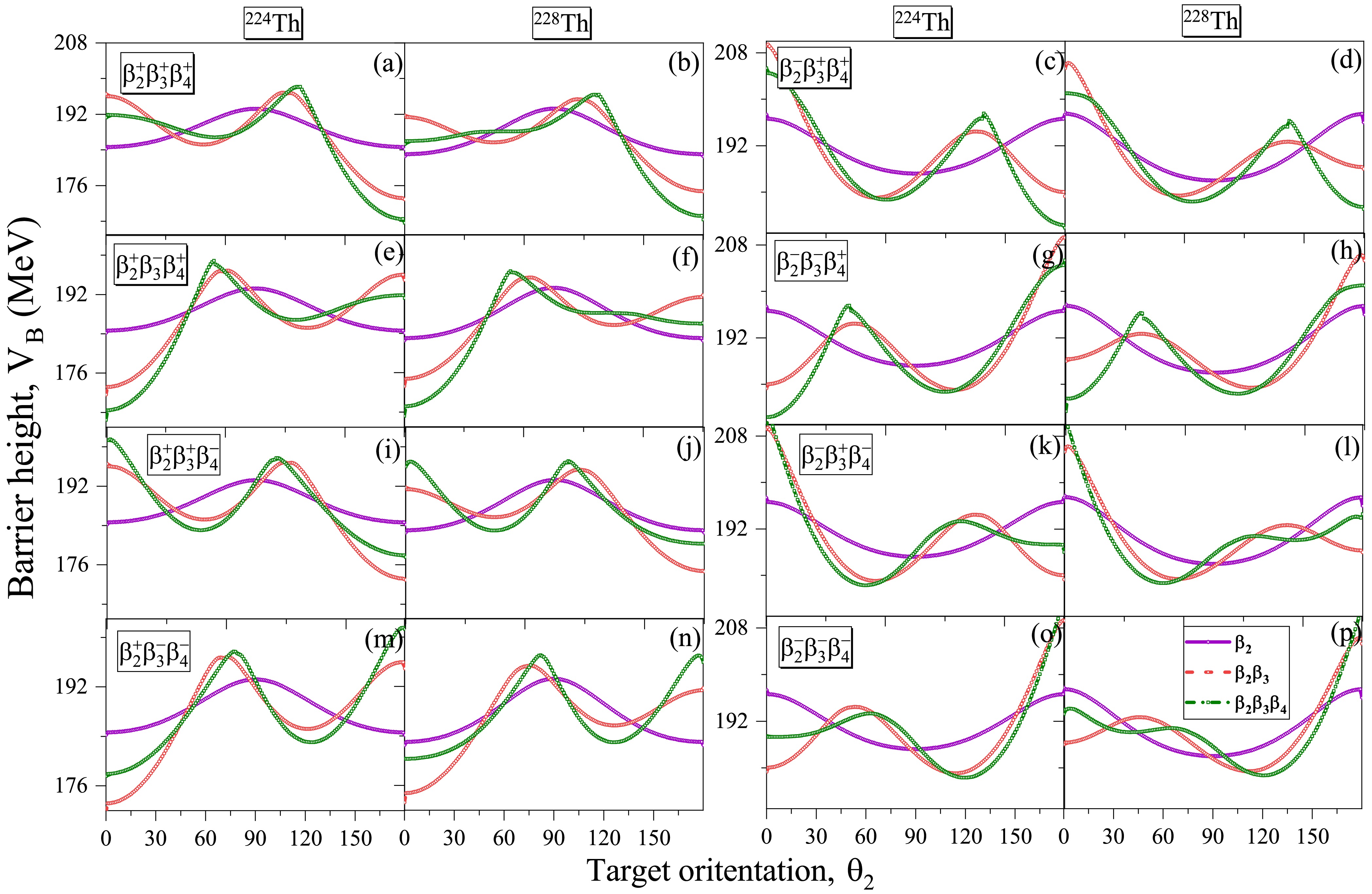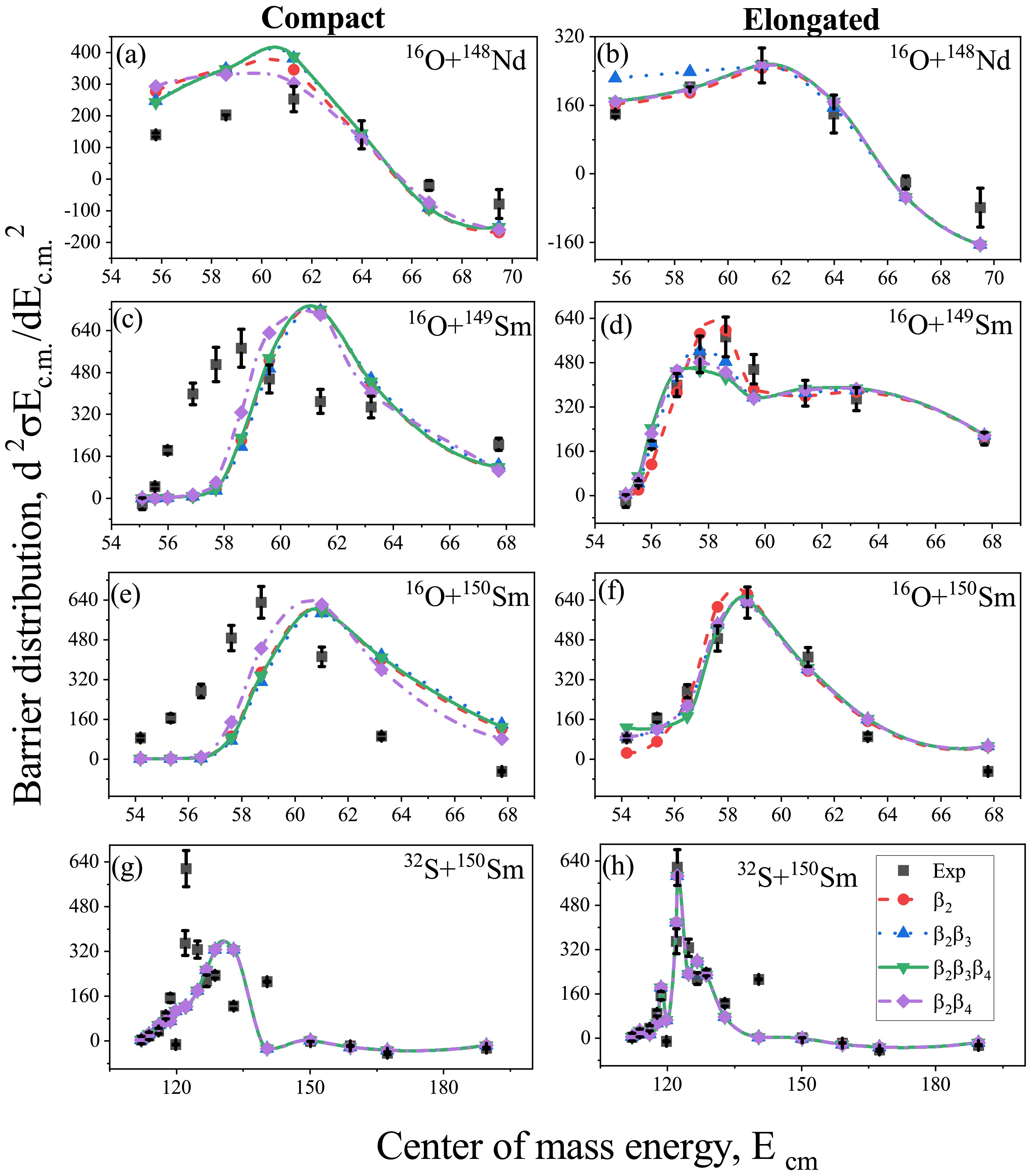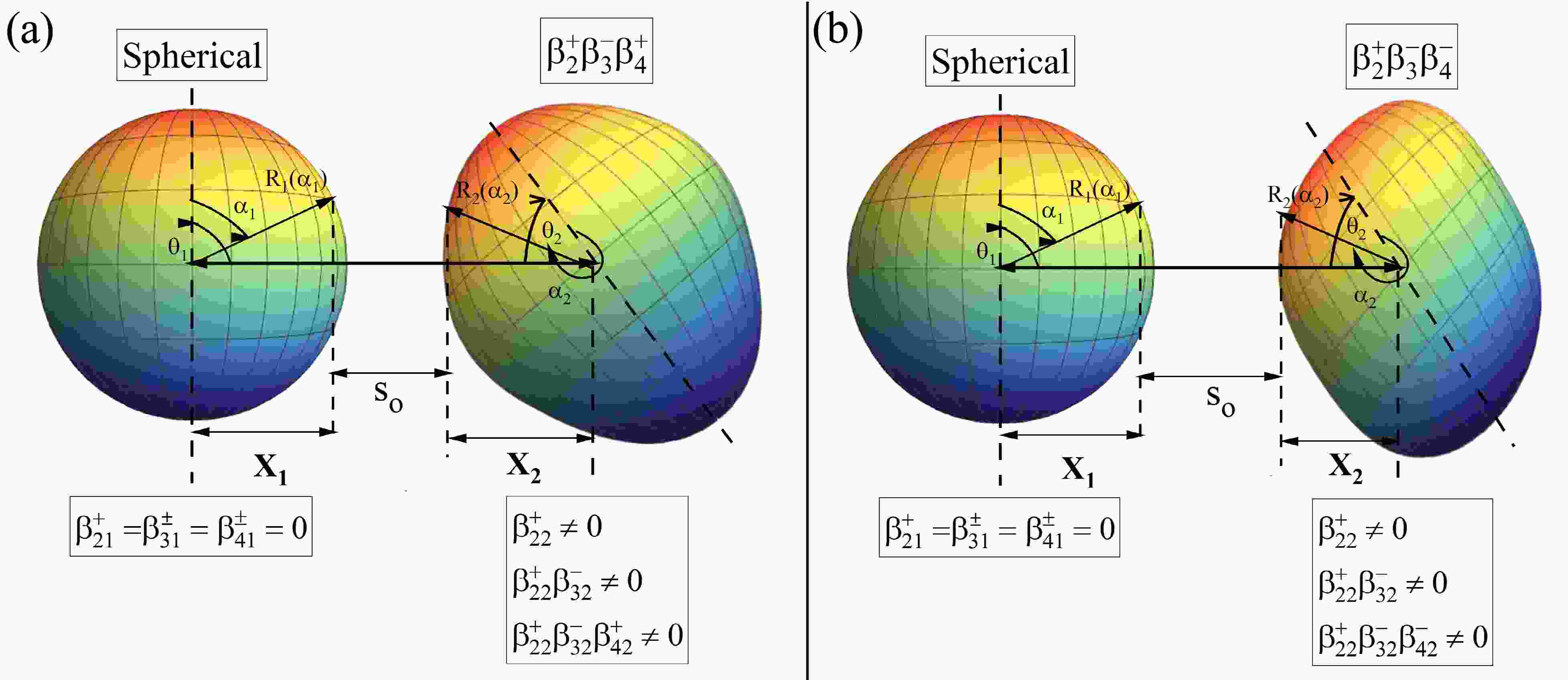-
The deviation of the nuclear shape from spherical symmetry due to multipole moments of different order gives rise to specific nuclear shapes with significant variation in radius vectors [1−3]. Numerous attempts have been made to investigate the impact of these deformed nuclear shapes associated with the projectile and target nuclei on the dynamics of heavy-ion-induced fusion reactions [4−25]. Initially, it was hypothesized that considering solely the quadrupole deformation (
$ \beta_2 $ ) would suffice for investigating the dynamics of fusion reactions. Numerous scientists have investigated the impact of quadrupole deformation ($ \beta_2 $ ) and have uncovered its significance alongside the orientation degree of freedom, in contrast to the spherical nuclei [26−35]. The study of orientation degree of freedom involves analyzing the compact (or elongated) configuration, also known as belly-to-belly (or pole-to-pole) configuration, which corresponds to the maximum (minimum) barrier height ($ V_B $ ) and smallest (largest) interaction radius ($ R_B $ ), respectively [29, 33, 36−38]. For instance, the elongated (pole-to-pole) configuration of prolate quadrupole ($ \beta_2^+ $ ) deformed nuclei lowers the fusion barrier and consequently enhances the reaction cross-sections. Conversely, the compact (belly-to-belly) configuration of quadrupole-deformed nuclei raises the fusion barrier, thereby reducing the cross-section [39]. In other words, based on these configurations, researchers have explored the relevance of deformations and orientation degrees of freedom in heavy-ion-induced fusion reactions for incident beam energies lying across the Coulomb barrier. In Refs. [36, 40, 41], the authors investigated the influence and significance of including the octupole deformation ($ \beta_3 $ ) alongside the quadrupole deformation ($ \beta_2 $ ) leading to pear-shaped nuclei [42]. These pear-shaped nuclei are further categorized in terms of the magnitude of octupole ($ \beta_3 $ ) deformation compared to the magnitude of quadrupole ($ \beta_2 $ ) deformation. While nuclei possessing a higher magnitude of$ \beta_3 $ deformation than that of$ \beta_2 $ deformation are called rigid-pear deformed nuclei, the nuclei possessing a smaller magnitude of$ \beta_3 $ deformation than that of$ \beta_2 $ deformation are termed as soft-pear deformed nuclei. In the aforementioned studies, it was demonstrated that the inclusion of higher-order deformations, i.e.,$ \beta_3 $ deformation in this case, significantly modifies the barrier characteristics as well as the optimum orientations. This impacts the dynamics of the reactions and, consequently, must be taken into account [40, 41, 43]. Discrepancies arose regarding the inclusion of higher-order deformations up to hexadecapole deformation ($ \beta_4 $ ), primarily because of an insufficient understanding of such deformations. Nevertheless, numerous studies have explored the effects of hexadecapole deformation in nuclear reaction dynamics [45−53]. However, the collective behavior and influence of quadrupole, octupole, and hexadecapole deformations in nuclei exhibiting all three types of deformation have not been explicitly analyzed. In a recent study of ours, we thoroughly investigated the impact of hexadecapole-deformed nuclei on the fusion dynamics of heavy-ion-induced fusion reactions. Our findings revealed that the incorporation of hexadecapole deformation of the target nuclei leads to significant modifications in characteristics of the fusion barrier ($ V_B $ and$ R_B $ ) as well as in the optimal orientation ($\theta_{\rm opt}$ ), and consequently, in the cross-sections of the fusion reactions. Furthermore, our observations also revealed that$ \beta_4 $ deformation of varying magnitudes and signs causes elongation and compression of nuclear shapes. These modifications in the nuclear shape have distinct effects on the aforementioned barrier characteristics ($ V_B $ and$ R_B $ ), ultimately influencing the dynamics of the reaction in specific manners [54, 55]. However, it is important to stress that we only explored the nuclei with axially symmetrical shapes and incorporated solely the$ \beta_2 $ and$ \beta_4 $ deformations for the coplanar systems. As described in [54], our findings motivated us to explore the collective effect of$ \beta_2 $ ,$ \beta_3 $ , and$ \beta_4 $ deformations. We found that the inclusion of all deformations up to$ \beta_4 $ exerts a greater influence on the barrier characteristics than any other combination of deformations, such as$ \beta_2^{\pm}\beta_3^{\pm} $ or$ \beta_2^{\pm}\beta_4^{\pm} $ .The variation in nuclear shape as deformations of varying orders are incorporated is shown in Fig. 1. This figure shows the expansion and contraction along the belly region of nuclei as well as the nuclear radius vector when deformations of all orders (up to
$ \beta_4^{\pm} $ ) having different signs are integrated with the quadrupole deformation ($ \beta_2^{\pm} $ ). The transition from spherical to ellipsoidal symmetry along the major/minor axis of the nuclei occurs according to the sign (±) of the associated quadrupole deformations ($ \beta_2^+ $ and$ \beta_2^- $ ), respectively, resulting in prolate and oblate deformed nuclei. Incorporating$ \beta_3^{\pm} $ to these prolate and oblate deformed nuclei breaks the reflection symmetry and gives rise to pear-shaped deformed nuclei. Interestingly, the inclusion of$ \beta_4^+ $ results in expansion along the major/minor axis according to the sign of$ \beta_2 $ and$ \beta_3^{\pm} $ , leading to the belly-out configuration of deformed nuclei. Similarly, incorporating$ \beta_4^- $ produces compression along the major/minor axis according to the sign of$ \beta_2 $ and$ \beta_3^{\pm} $ , resulting in the belly-in configuration of deformed nuclei. This change in the nuclear shape and symmetry leads to a change in the respective radius vector of the deformed target nuclei, which heavily affects the reaction dynamics. Figure 1 also shows the configuration of the Spherical +$ \beta_2^+\beta_3^-\beta_4^{\pm} $ deformed nuclei, depicting the altered geometry and its impact on the shortest distance ($ s_o $ ) calculated between the colliding nuclei.
Figure 1. (color online) Geometrical representation of (a) Spherical +
$ \beta_2^+\beta_3^-\beta_4^+ $ and Spherical +$ \beta_2^+\beta_3^-\beta_4^- $ deformed nuclear partners colliding in a plane; the minimum separation distance$ s_o $ between the two colliding surfaces facing each other was obtained according to the method described in [44].The present study investigated the cumulative impact of the nuclear shape (due to higher-order deformations up to
$ \beta_4 $ ) on the dynamics of heavy-ion-induced fusion reactions. Additionally, we analyzed the effect of various signs of the considered deformations, namely ($ \beta_2^+\beta_3^+\beta_4^+ $ ,$ \beta_2^+\beta_3^+\beta_4^- $ ,$ \beta_2^+\beta_3^-\beta_4^+ $ ,$ \beta_2^+\beta_3^-\beta_4^- $ ,$ \beta_2^-\beta_3^+\beta_4^+ $ ,$ \beta_2^-\beta_3^+\beta_4^- $ ,$ \beta_2^-\beta_3^-\beta_4^+ $ ,$ \beta_2^-\beta_3^-\beta_4^- $ ), on the barrier characteristics. To conduct this analysis, we considered the reactions with$ ^{148} {\rm{Nd}}$ ,$ ^{149} {\rm{Sm}}$ , and$ ^{150} {\rm{Sm}}$ targets, which possess$ \beta_2 $ ,$ \beta_3 $ , and$ \beta_4 $ deformations, with spherical beams of$ ^{16} {\rm{O}}$ and deformed beams of$ ^{32} {\rm{S}}$ . The inclusion of higher-order deformations leads to better agreement with available experimental data and helps understand the collective influence of the shape of target nuclei on the reaction dynamics.The present manuscript is organized as follows. In Section II, the formalism of the extended ℓ-summed Wong model and the contributing potentials used to conduct the proposed analysis are summarized. In Section III, the results and observations of this analysis are discussed, followed by a summary of the manuscript in Section IV.
-
The shape of the deformed nuclear surface can be expressed using the radius vector
$ R_i(\alpha_i) $ , which involves the spherical harmonics$ Y_{\lambda}^{(0)}(\alpha_i) $ of higher order, i.e.,$\lambda = 2,3,4$ [56−59], as$\begin{aligned}[b] R_i(\alpha_i) =\;& R_{0i}\left[1+\sum\limits_{\lambda = 2,3,4}\beta_{\lambda i}Y_{\lambda i}^{(0)}(\alpha_i)\right] \\=\;& R_{0i}\left[1+\sum\limits_{\lambda = 2,3,4}\beta_{\lambda i}\sqrt{\frac{2\lambda+1}{4\pi}}P_{\lambda}(\cos{\alpha_i})\right],\end{aligned} $

(1) where i = 1, 2 corresponds to projectile and target nuclei, respectively;
$ R_{0i}( = 1.28A^{1/3}_i-0.76+0.8A^{-1/3}_i) $ in fm [60] represents the radius of the equivalent spherical nuclei;$ \beta_{\lambda i} $ is the static deformation parameter taken from the Data Table of M$ \ddot{o} $ ller et al. [59];$ \lambda = 2,3,4 $ defines the quadrupole, octupole, and hexadecapole deformed shapes, respectively; and$ P_{\lambda}(\cos{\alpha_i}) $ is the Legendre polynomial. Angle details are provided in [54]. The above radius term is introduced in the total interaction potential and its constituent terms, which are discussed below. -
To study heavy-ion induced reactions in the low-energy regime, the total interaction potential, denoted as
$ V_T(R) $ , is an important tool defined as the combination of Coulomb potential,$V_{\rm C}(R)$ , centrifugal potential,$ V_{\ell}(R) $ , and nuclear potential,$ V_N(R) $ . The deformations (up to$ \beta_4 $ ) and relative orientation ($ \theta_i $ ) of deformed nuclei are incorporated in the aforementioned contributing potentials. Thus, the total potential$ V_T(R,A_1,A_2,\beta_{\lambda{1}},\beta_{\lambda{2}},\theta_1,\theta_{2}) $ is defined as$ \begin{aligned}[b] V_T(R,A_1,A_2,\beta_{\lambda1},\beta_{\lambda2},\theta_1,\theta_2) =\;& V_{\rm C}(R,Z_1,Z_2,\beta_{\lambda1},\beta_{\lambda2},\theta_1,\theta_2)\\&+V_{\ell}(R,A_1,A_2,\beta_{\lambda1},\beta_{\lambda2},\theta_1,\theta_2)\\ &+V_N(R,A_1,A_2,\beta_{\lambda1},\beta_{\lambda2},\theta_1,\theta_2). \end{aligned} $

(2) where
$ i = 1,2 $ represents the projectile and target nuclei, respectively. The Coulomb potential$V_{\rm C}(R,Z_i,\beta_{\lambda i},\theta_i)$ for deformed-deformed pairs of colliding nuclei [61, 62] is defined as$\begin{aligned}[b]& V_{\rm C}(R,Z_1,Z_2,\beta_{\lambda1},\beta_{\lambda2},\theta_1,\theta_2) = \frac{Z_1Z_2e^2}{R}\\&\quad+ Z_1Z_2e^2\sum\limits_{\lambda = 2,3,4}\left(\frac{R_i^{\lambda}(\alpha_i)}{R^{\lambda+1}}\right)\beta_{\lambda}Y_\lambda^{(0)}(\theta_i)\\&\quad\times\left[\frac{3}{2\lambda+1}+\left(\frac{12}{7(2\lambda+1)}\right)\beta_{\lambda}Y_\lambda^{(0)}(\theta_i)\right].\end{aligned} $

(3) It is important to note that for the spherical projectiles, the second term of this equation will have terms only for
$ i = 2 $ , i.e., deformed targets, for instance$ \beta_{21} = 0.0 $ and$ \beta_{22}\neq0.0 $ .The centrifugal potential
$ V_{\ell}(R,A_i,\beta_{\lambda i},\theta_i) $ in the form of rotational kinetic energy is expressed as$ V_\ell(R,A_1,A_2,\beta_{\lambda1},\beta_{\lambda2},\theta_1,\theta_2) = \frac{\hbar^2{\ell(\ell+1)}}{2I};I = \mu R^2. $

(4) In Eq. (2), the nucleus-nucleus interaction potential,
$ V_N(R,A_i,\beta_{\lambda i},\theta_i) $ , is defined on the basis of the 'Proximity Theorem,' as reported by Blocki et al. [60], as the product of$ 4\pi\bar{R}\gamma b $ , which is a function of the shape and geometry of the colliding nuclei, and$ \Phi(s_0) $ , universal function depending on the shortest distance between the interacting nuclei [44, 60]. Thus,$ V_{N}(R,A_i,\beta_{\lambda i},\theta_i) $ is expressed as$ V_{N}(R,A_i,\beta_{\lambda i},\theta_i) = 4\pi\bar{R}\gamma b\Phi(s_0), $

(5) where
$ s_0 $ is the minimum separation distance between the two facing surfaces of interacting nuclei;$ \bar{R} $ is the mean curvature radius expressed in terms of the radii of curvatures$ R_{i1} $ and$ R_{i2} $ for co-planar nuclei as [60]$ \frac{1}{\bar{R}^2} = \frac{1}{R_{11}R_{12}}+\frac{1}{R_{21}R_{22}}+\frac{1}{R_{11}R_{22}}+\frac{1}{R_{21}R_{12}}. $

(6) The principal radii of curvature (
$ R_{i1} $ and$ R_{i2} $ ) for spherical-deformed and deformed-deformed cases is expressed as [63]$ \begin{aligned}[b]& R_{i1}(\alpha_i) = \frac{\left[R_i^2(\alpha_i)+R_i^{' 2}(\alpha_i)\right]^{3/2}}{R_i^2(\alpha_i)+2R_i^{' 2}(\alpha_i)-R_i(\alpha_i)R_i^{''}(\alpha_i)},\\& R_{i2}(\alpha_i) = \frac{R_i(\alpha_i)\sin{\alpha_i}}{\cos{(\pi/2-\alpha_i-\delta_i)}}. \end{aligned} $

(7) In this equation,
$ R^{'}_i(\alpha_i) $ and$ R^{''}_i(\alpha_i) $ represent the first- and second-order derivatives, respectively, of the radius vector$ R_i(\alpha_i) $ with respect to the angle$ \alpha_i $ .Note that, for spherical projectiles,
$R_{11(\alpha_1)} = R_{12}(\alpha_1) = R_1(\alpha_1)$ .In Eq. (5) [60], γ is the surface energy constant. It is expressed in axially symmetric terms as
$ \gamma = 0.9517\left[1-1.7826\left(\frac{N-Z}{A}\right)^2\right] \; \text{MeVfm}^{-2}, $

(8) where 'b' is the surface thickness, which takes a value of 0.99 fm.
The universal function with single parameter
$ s_0 $ in Eq. (5) is expressed as$ \Phi(s_0) = \left\{ \begin{array}{l} -\dfrac{1}{2}(s_0-2.54)^2-0.0852(s_0-2.54)^3, \\ \;\;\;\;\;\;\;\;\;\;\;\;\;\;\;\;\;\;\;\;\;\;\;\;\;\;\;\;\;\;\;\;\;\;\;\;\; s_0\leq1.2511\; \text{fm} \\ -3.437\exp\left({-\dfrac{s_0}{0.75}}\right), s_0>1.2511 \;\text{fm}. \end{array} \right. $

(9) According to Eqs. (2)−(9), which define the total interaction potential, it is possible to derive the fusion barrier characteristics, i.e., barrier height
$ V_B $ , barrier position$ R_B $ , and barrier curvature$ \hbar\omega_B $ , which are influenced by deformation and orientation degrees of freedom. These terms are employed in the calculations of capture cross-sections. -
The capture cross-section, expressed in terms of angular-momentum (ℓ) partial waves for deformed and oriented nuclei lying in the same planes and colliding with the center-of-mass energy,
$E_{\rm c.m.}$ , is defined using the extended ℓ-summed Wong formula of the one-dimensional penetration model as$ \sigma_{\rm cap}(E_{\rm c.m.},\theta_i) = \sum\limits_{\ell = 0}^{\ell_{\max}}\sigma_{\ell} = \frac{\pi}{k^2}\sum\limits_{\ell = 0}^{\ell_{\max}}(2\ell+1)P_{\ell}, $

(10) where
$k = \sqrt{\dfrac{2\mu E_{\rm c.m.}}{\hbar^2}}$ and μ is the reduced mass.$ P_{\ell} $ is the transmission coefficient for each value of ℓ; it describes the penetration probability across the Coulomb barrier. Here,$\ell_{\max}$ is the maximum angular momentum calculated using the sharp cut-off approximation [64−67] for above barrier energies and extrapolated for the below barrier center-of-mass energies$E_{\rm c.m.}$ , expressed as$ \sigma_{\rm Exp} = \pi\lambda^2(\ell_{\rm max}+1)^2 $

(11) In the present study, the penetration probability
$ P_{\ell} $ was obtained using the Hill-Wheeler [68] approximation, defined as$ P^{\rm HW}_{\ell}(E_{\rm c.m}) = \Bigg[1+\exp{\bigg(\frac{2 \pi [V_{B}^{\ell}-E_{\rm c.m.}]}{\hbar \omega_{\ell}}\bigg)}\bigg]^{-1}, $

(12) The Hill-Wheeler approximation assumes a parabolic interaction barrier, resulting in an analytical expression for transmission that is commonly used in heavy-ion fusion reactions. We adopted this expression in the present study. In Eq. (12),
$ V_{B}^{\ell} $ ,$ R_{B}^{\ell} $ , and$ \hbar\omega_{B}^{\ell} $ represent the barrier height, position, and curvature, respectively, which are extracted from the total interaction potential$ V_{T} $ [61]. To analyze the effect of deformations up to the order of hexadecapole deformation over all the orientations, the fusion cross-sections were integrated over$ \theta_i $ with a step of$ 10^\circ $ for spherical-deformed and deformed-deformed combinations as$ \sigma_{\rm int}(E_{\rm c.m.}) = \int_{\theta_i = 0}^{\pi}\sigma(E_{\rm c.m.},\theta_i)\sin{\theta_i}{\rm d}\theta_i. $

(13) -
In the present study, we analyzed the collective influence of the sign and magnitude of higher-order deformations on the fusion reaction dynamics by progressively incorporating deformations up to
$ \beta_4 $ (i.e.,$ \beta_2 $ ,$ \beta_3 $ , and$ \beta_4 $ ) of the target nuclei, with spherical as well as$ \beta_2 $ deformed projectiles. To perform an extensive analysis, we considered soft-deformed$ ^{228} {\rm{Th}}$ having a magnitude of octupole deformation less than that of quadrupole deformation (i.e., |$ \beta_3|<|\beta_2 $ |) and rigid deformed$ ^{224} {\rm{Th}}$ having a magnitude of octupole deformation higher than that of quadrupole deformation (i.e.,$ \beta_3>\beta_2 $ ) of Th nuclei (Z = 90) having significant magnitudes of$ \beta_2 $ ,$ \beta_3 $ , and$ \beta_4 $ deformations taken from the Data Table of M$ \ddot{o} $ ller et al. [59]. To examine the collective effect of these deformations, we performed calculations to observe the changes in curvature ($ \hbar\omega $ ), barrier position ($ R_B $ ), and barrier height ($ V_B $ ) as functions of the orientation of the target nuclei ($ \theta_2 $ ). This was achieved by sequentially incorporating the quadrupole$ \beta_2 $ , octupole$ \beta_3 $ , and hexadecapole$ \beta_4 $ deformations, as depicted in Fig. 2. This figure shows distinct variations in the curvature$ \hbar\omega $ , barrier position$ R_B $ , and barrier height$ V_B $ as we incorporate deformations of increasing orders up to$ \beta_4 $ . This figure shows a significant modification in the barrier characteristics and variation in the orientation angle θ of compact and elongated configurations with inclusion of deformation of different orders.
Figure 2. (color online) Variation in the barrier height
$ V_B $ as a function of the relative orientation ($ \theta_2 $ ) of the soft ($ ^{228} {\rm{Th}}$ ) and rigid ($ ^{224} {\rm{Th}}$ )$ \beta_2\beta_3\beta_4 $ deformed target nuclei for various combinations of$ \beta_2^{\pm},\beta_3^{\pm} $ , and$ \beta_4^{\pm} $ deformations.To explore collective impact of higher-order deformations in the context of the signs of quadrupole (
$ \beta_2 $ ), octupole ($ \beta_3 $ ), and hexadecapole ($ \beta_4 $ ) deformations, we analyzed the variation in the barrier height ($ V_B $ ) with respect to target orientation ($ \theta_2 $ ) for various configurations exhibiting unique sign combinations of these deformations. In particular, we examined the configurations$ \beta_2^+\beta_3^+\beta_4^+ $ ,$ \beta_2^+\beta_3^+\beta_4^- $ ,$ \beta_2^+\beta_3^-\beta_4^+ $ ,$ \beta_2^+\beta_3^-\beta_4^- $ ,$ \beta_2^-\beta_3^+\beta_4^+ $ ,$ \beta_2^-\beta_3^+\beta_4^- $ ,$ \beta_2^-\beta_3^-\beta_4^+ $ , and$ \beta_2^-\beta_3^-\beta_4^- $ by changing the signs of deformations associated with$ ^{224} {\rm{Th}}$ and$ ^{228} {\rm{Th}}$ nuclei, taken from the Data Table of M$ \ddot{o} $ ller et al. [59], as depicted in Fig. 3. This figure shows significant variations in the barrier height$ V_B $ as the deformations are progressively incorporated up to hexadecapole$ \beta_4 $ deformation. While experimental evidence supporting positive octupole deformation is not available, theoretical analysis based on theoretical values emphasizes that the maximum and minimum values of the barrier height$ V_B $ remain mostly unchanged despite alterations in the sign of the octupole deformation. By contrast, there is a notable change in the orientation angle due to inversion of symmetry corresponding to the maximum and minimal barrier height$ V_B $ . To investigate these variations and elucidate the collective behavior, we analyzed the alterations in the barrier height$ V_B $ for the considered combinations of deformations with different signs and orders, as depicted in Fig. 4. In this figure, the variation in the barrier height$ V_B $ is represented for different combinations of deformations. Note that there is a significant decrease in the barrier height$ V_B $ when the positive hexadecapole deformation$ \beta_4^+ $ is involved, while a notable increase is observed for negative hexadecapole deformation$ \beta_4^- $ . Note also that all the configurations follow this trend, with the exception of the configurations involving$ \beta_2 $ and$ \beta_4 $ deformations of the same sign. For instance,$ \beta_2^+\beta_3^{\pm}\beta_4^+ $ and$ \beta_2^-\beta_3^{\pm}\beta_4^- $ combinations exhibit the same trend, but only in either the compact or elongated configuration. In contrast, the other configuration shows an opposite effect or minimal change. For example, for the$ \beta_2^+\beta_3^{\pm}\beta_4^+ $ combination, a reduced barrier height$ V_B $ is observed only in the elongated configuration. This occurs because the addition of$ \beta_4^+ $ significantly expands the nuclear shape along the major axis, while only a minor expansion occurs along the minor axis. The opposite effect is observed for the$ \beta_2^-\beta_3^{\pm}\beta_4^- $ combination. A similar pattern is observed for the$ ^{228} {\rm{Th}}$ isotope. The analysis extends to the barrier position$ R_B $ , where combinations with positive hexadecapole deformation$ \beta_4^+ $ show an increment in$ R_B $ , while those with negative hexadecapole deformation experience a decrement in$ R_B $ when combined with$ \beta_2^{\pm}\beta_3^{\pm} $ . These changes in$ V_B $ and$ R_B $ correspondingly influence the orientation angle of elongated and compact configurations (based on the sign of the quadrupole deformation$ \beta_2 $ ). Such enhancement/decrement in the barrier characteristics resulting from the considered combinations gives rise to new compact and elongated configurations.
Figure 3. (color online) Variation in the barrier height
$ V_B $ as a function of the relative orientation$ \theta_2 $ of the soft ($ ^{228} {\rm{Th}}$ ) and rigid ($ ^{224} {\rm{Th}}$ )$ \beta_2\beta_3\beta_4 $ deformed target nuclei for various combinations of$ \beta_2^{\pm},\beta_3^{\pm} $ , and$ \beta_4^{\pm} $ deformations.
Figure 4. (color online) Variation in the barrier height
$ V_B $ for various combinations of$ \beta_2^{\pm},\beta_3^{\pm} $ , and$ \beta_4^{\pm} $ deformations of$ \beta_2\beta_3\beta_4 $ deformed target nuclei$ ^{224} {\rm{Th}}$ at their respective compact and elongated configurations.Based on the above results, the variations in
$ V_B $ and$ R_B $ due to the collective incorporation of deformations of different orders and signs, mainly$ \beta_3 $ and$ \beta_4 $ , in conjunction with the quadrupole deformation$ \beta_2 $ allowed us to analyze the collective and specific effects of higher-order deformations on the overall nuclear reaction dynamics. To conduct this analysis, we selected the reactions involving the$ \beta_2\beta_3\beta_4 $ deformed nuclei ($ ^{148} {\rm{Nd}}$ ,$ ^{149,150} {\rm{Sm}}$ ) as target nuclei, with spherical ($ ^{16} {\rm{O}}$ ) and$ \beta_2 $ deformed ($ ^{32} {\rm{S}}$ ) projectile beams. To generalize our results, we investigated the variation in the barrier characteristics, namely$ V_B $ ,$ R_B $ , and$ \hbar\omega $ , corresponding to the target orientation$ \theta_2 $ , for progressive incorporation of quadrupole ($ \beta_2 $ ), octupole ($ \beta_2\beta_3 $ ), and hexadecapole ($ \beta_2\beta_3\beta_4 $ ) deformations, as depicted in Fig. 5 for the considered reactions. This figure shows similar changes in the curvature ($ \hbar\omega $ ), barrier position ($ R_B $ ), and barrier height ($ V_B $ ) for such reactions, represented in Figs. 5(a)−(d), Figs. 5(e)−(h), and Figs. 5(i)−(l), respectively, as shown in Fig. 2. For the elongated configuration ($ \theta_2 = 0^\circ $ ), the incorporation of$ \beta_4^+ $ along with$ \beta_2^{\pm}\beta_3^{\pm} $ leads to elongation of the nuclear shape resulting in consistent reduction of the barrier height$ V_B $ and increase in the barrier position$ R_B $ . In addition to the magnitude of these parameters, we also observed a significant shift in the orientation angle of the compact and elongated configurations as we progressed toward higher-order deformations, as predicted in [55].
Figure 5. (color online) Variations in the barrier curvature
$ \hbar\omega $ (a)−(d), barrier position$ R_B $ (e)−(h), and barrier height$ V_B $ (i)−(l) as functions of the relative orientation$ \theta_2 $ of the$ \beta_2^+\beta_3^-\beta_4^- $ deformed target nuclei for P-T combinations$ ^{16} {\rm{O}}$ +$ ^{150} {\rm{Sm}}$ ,$ ^{32} {\rm{O}}$ +$ ^{150} {\rm{Sm}}$ ,$ ^{16} {\rm{O}}$ +$ ^{148} {\rm{Nd}}$ , and$ ^{16} {\rm{O}}$ +$ ^{149} {\rm{Sm}}$ , respectively.We also analyzed the corresponding effects of these variations in the barrier height
$ V_B $ , barrier position$ R_B $ , and barrier curvature$ \hbar\omega $ on the capture cross-section$\sigma_{\rm cap}(E_{\rm c.m.})$ of the considered P-T combinations obtained by the extended ℓ-summed model. Figure 6 shows the change in the capture cross-section$\sigma_{\rm cap}(E_{\rm c.m.})$ for different combinations of quadrupole$ \beta_2 $ , octupole$ \beta_3 $ , and hexadecapole$ \beta_4 $ deformations at their respective compact and elongated configurations. In particular, this figure shows the variation in the capture cross-section when different combinations of deformations up to$ \beta_4 $ , i.e.,$ \beta_2,~ \beta_2\beta_3,~ \beta_2\beta_3\beta_4 $ , and$ \beta_2\beta_4 $ , are incorporated in compact and elongated configurations across the barrier center-of-mass energies ($E_{\rm c.m.}$ ). The calculated values of$\sigma_{\rm cap}(E_{\rm c.m.})$ for all the considered cases are compared with available experimental data [70−72]. The experimental data include all orientations. Through this comparison, we analyzed the improvement in the cross-sections when changing from compact to spherical and elongated configurations of$ \beta_2\beta_3\beta_4 $ deformation, especially below and near barrier energies. However, there is still some hindrance observed in$\sigma_{\rm cap}(\beta_2\beta_3\beta_4)$ (elong.) from$\sigma_{\rm cap}^{\rm Expt}$ for certain cases, particularly in the sub-barrier region. This can be further investigated by incorporating additional degrees of freedom, such as non-axial or non-coplanar symmetries. It is important to note that, to capture the average effect of the orientation degree of freedom—without being restricted to specific compact or elongated configurations—the integrated cross-sections over all mutual orientations of the deformed nuclei were calculated; they presented in Fig. 7. The experimental data encompass all orientations; however, a comparison between the calculated cross-sections for compact and elongated configurations and the experimental data was conducted to assess the consistency of the results for specific target nucleus orientations corresponding to the highest and lowest values of the barrier height$ V_B $ . In this experimental context, we also calculated the cross-sections integrated over all orientations to further support our findings in Fig. 7. The integrated cross-sections shown in Fig. 7 are plotted for different combinations of deformations up to$ \beta_4 $ , i.e.,$ \beta_2,~ \beta_2\beta_3, ~\beta_2\beta_3\beta_4 $ , and$ \beta_2\beta_4 $ . Note that the integrated cross-sections also confirm a minor enhancement in the cross-sections after the incorporation of deformations up to$ \beta_4 $ . Also note that the target nuclei considered in the present study exhibit positive hexadecapole deformation$ \beta_4^+ $ only. Consequently, the inclusion of deformations up to$ \beta_4 $ reduces the potential barrier, thereby enhancing the capture cross-sections$\sigma_{\rm cap}$ . Conversely, if the considered target nuclei had negative hexadecapole deformation$ \beta_4^- $ , the inclusion of deformations up to$ \beta_4 $ would result in an increased potential barrier, ultimately hindering the capture cross-sections.
Figure 6. (color online) Capture cross-sections (
$\sigma_{\rm cap}$ ) calculated using the extended ℓ-summed Wong model [69] for the P-T combinations (a)$ ^{16} {\rm{O}}$ +$ ^{148} {\rm{Nd}}$ , (b)$ ^{16} {\rm{O}}$ +$ ^{149} {\rm{Sm}}$ , (c)$ ^{16} {\rm{O}}$ +$ ^{150} {\rm{Sm}}$ , and (d)$ ^{32} {\rm{S}}$ +$ ^{150} {\rm{Sm}}$ , respectively, as a function of$E_{\rm c.m.}$ . The calculated values of$\sigma_{\rm cap}$ for the considered choices of projectile-target combinations are compared with available experimental data for incident energies lying across the Coulomb barrier.
Figure 7. (color online) Capture cross-sections integrated over possible orientations (
$\sigma_{\rm Int}$ ) calculated using the extended ℓ-summed Wong model [69] for the P-T combinations (a)$ ^{16} {\rm{O}}$ +$ ^{148} {\rm{Nd}}$ , (b)$ ^{16} {\rm{O}}$ +$ ^{149} {\rm{Sm}}$ , (c)$ ^{16} {\rm{O}}$ +$ ^{150} {\rm{Sm}}$ , and (d)$ ^{32} {\rm{S}}$ +$ ^{150} {\rm{Sm}}$ , respectively, as a function of$E_{\rm c.m.}$ . The calculated values of$\sigma_{\rm Int}$ for the considered choices of projectile-target combinations are compared with available experimental data for incident energies lying across the Coulomb barrier.To gain insight into the dynamics of the reaction, we analyzed the barrier distributions,
${\rm d}^2{\sigma}E_{\rm c.m.}/{{\rm d}E_{\rm c.m.}}^2$ , for various combinations of deformations at different orders with respect to the center-of-mass energy$E_{\rm c.m.}$ . The obtained results were then compared with the experimental barrier distributions for both the compact and elongated configurations, as depicted in Fig. 8. In this figure, the barrier distribution from progressive incorporation of deformation up to$ \beta_4 $ is shown for both the compact and elongated configurations. Note that the$ \beta_3 $ and$ \beta_4 $ deformations for the considered reactions have lower magnitude than that of$ \beta_2 $ . Thus, the impact of higher-order deformations on the barrier distribution is not directly observable. However, upon examining this figure, a trend emerges, with peaks corresponding to the associated deformations of the P-T system. Notably, the results for elongated configurations align more closely with the experimental distributions than those for compact configurations. Consequently, the cross-sections derived from the elongated configurations provide stronger evidence in comparison with the experimental data. This further reinforces the fact that the incorporation of all the deformation up to$ \beta_4 $ offers a deeper insight into the reaction dynamics.
Figure 8. (color online) Barrier distributions for different combinations of deformations for P-T combinations (a)
$ ^{16} {\rm{O}}$ +$ ^{148} {\rm{Nd}}$ , (b)$ ^{16} {\rm{O}}$ +$ ^{149} {\rm{Sm}}$ , (c)$ ^{16} {\rm{O}}$ +$ ^{150} {\rm{Sm}}$ , and (d)$ ^{32} {\rm{S}}$ +$ ^{150} {\rm{Sm}}$ , respectively, as functions of center-of-mass energy$ E_{\rm c.m.} $ . The calculated values of$ {\rm d}^2{\sigma}E_{\rm c.m.}/{{\rm d}E_{\rm c.m.}}^2 $ for the considered choices of projectile-target combinations are compared with available experimental data [70−72] for incident energies lying across the Coulomb barrier.To assess the impact of higher-order deformations on barrier distribution, we conducted calculations for both soft and rigid deformed Th isotopes. These calculations were based on capture cross-sections measured at various center-of-mass energies across the barrier, considering both compact and elongated configurations. The results are presented in Figs. 9(a)−(b) and Figs. 9(c)−(d), respectively. Note the differences in the distribution as we progressively incorporated the higher-order deformations
$ \beta_3 $ and$ \beta_4 $ . Notably, a clear deviation is observed in both the peak position and height when incorporating deformations up to$ \beta_4 $ . This figure highlights how higher-order deformations influence the barrier distribution curves. Specifically, the shift in peak position for both compact and elongated configurations signifies changes in barrier height and corresponding barrier energy as$ \beta_2 $ and higher-order deformations are included. For compact configurations, the peaks shift toward higher energies with the inclusion of higher-order deformations, whereas for elongated configurations, the peaks shift toward lower energies. This trend reflects the evolving barrier characteristics due to these deformations. Additionally, the inclusion of higher-order deformations significantly alters the peak height, enhancing the feasibility of the reaction.
Figure 9. (color online) Barrier distributions, i.e.,
${\rm d}^2{\sigma}E_{\rm c.m.}/{{\rm d}E_{\rm c.m.}}^2$ , for different combinations of deformations for$ ^{224} {\rm{Th}}$ and$ ^{228} {\rm{Th}}$ , i.e.,$ \beta_2 $ ,$ \beta_2\beta_3 $ ,$ \beta_2\beta_3\beta_4 $ , and$ \beta_2\beta_4 $ at their (a)−(b) compact and (c)−(d) elongated configuration respectively, as functions of the center-of-mass energy$E_{\rm c.m.}$ lying across the Coulomb barrier.In essence, deformations up to order of
$ \beta_4 $ collectively influences the barrier characteristics and cross-sections. Neglecting any order of deformation can lead to significant deviations in the outcomes. Therefore, proper inclusion of higher-order deformations is desirable for further understanding of the nuclear dynamics. -
In the present study, the collective relevance of higher-order deformations, specifically up to hexadecapole
$ \beta_4 $ deformation, was analyzed. This analysis employed$ \beta_2\beta_3\beta_4 $ deformed targets and investigated their impact on the fusion barrier characteristics and fusion cross-sections. The calculations were performed at$ \theta_{\rm opt} $ for both "elongated" and "compact" configurations of the interacting deformed nuclei to address the reaction dynamics across the Coulomb barrier.It was observed that nuclei possessing all three deformations, namely
$ \beta_2 $ ,$ \beta_3 $ , and$ \beta_4 $ (for instance,$ ^{148} {\rm{Nd}}$ and$ ^{149,150} {\rm{Sm}}$ ), provide a precise insight of fusion barrier characteristics and reaction dynamics when the deformations up to hexadecapole$ \beta_4 $ are incorporated.Furthermore, a comparison was made between the theoretically calculated capture cross-sections (
$\sigma_{\rm cap}$ ) and available experimental data for reactions involving$ \beta_2\beta_3\beta_4 $ deformed target nuclei. It was discovered that the calculated values of$ \sigma_{\rm cap} $ using the extended ℓ-summed Wong model improve significantly when all deformations up to$ \beta_4 $ are incorporated, along with the corresponding elongated optimum orientations across the Coulomb barrier. Along with the cross-sections, the barrier distribution curves also provide a good agreement with the experimental results after incorporating deformations of all orders up to$ \beta_4 $ at the elongated configurations.In conclusion, a comprehensive examination of deformations up to
$ \beta_2\beta_3\beta_4 $ leads to further understanding of the fusion barrier characteristics and reaction dynamics compared to the$ \beta_2 $ and$ \beta_2\beta_3 $ scenarios. The aforementioned analysis has confirmed that the inclusion of$ \beta_4^+ $ deformation in$ \beta_2^{\pm}\beta_3^{\pm} $ enhances the reaction cross-sections, while the incorporation of$ \beta_4^- $ deformation in$ \beta_2^{\pm}\beta_3^{\pm} $ hinders the reaction cross-sections. In this study, we investigated the collective impact of deformations up to$ \beta_4 $ on the reaction dynamics. Questions raise regarding the need for an additional degree of freedom such as the non-axial or non-coplanar degree of freedom in both the entrance and exit channels of nuclear interactions. It is interesting to incorporate the non-coplanar interactions in future studies. Such theoretical analysis will contribute to a more comprehensive understanding of the structural properties, stability, and dynamics of nuclear interactions involving higher-order deformed nuclei.
Collective impact of higher-order deformations of target nuclei on the fusion dynamics of heavy-ion induced reactions
- Received Date: 2024-12-24
- Available Online: 2025-06-15
Abstract: Several studies on fusion reaction dynamics focused on the impact of quadrupole





 Abstract
Abstract HTML
HTML Reference
Reference Related
Related PDF
PDF
































 DownLoad:
DownLoad: